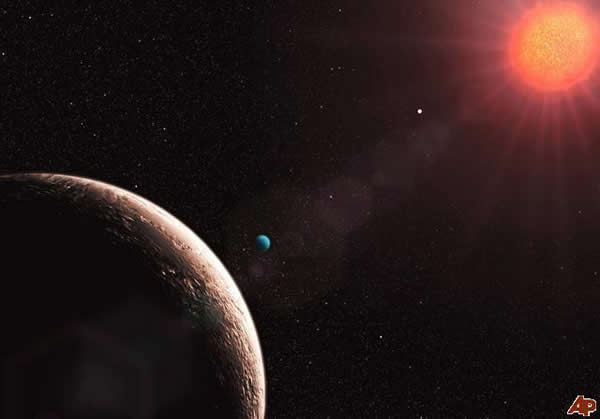What If Earth Became Tidally Locked?
Artist's impression of the newly discovered planetary system Gliese 581.
There's a reason we only ever see one side of the Moon. It's tidally locked to the Earth, presenting only one side to us as it orbits around the planet. Tidal locking is a fate that befalls lots of planetary bodies, and it can wreak havoc on the surface.
Why does tidal locking happen? And more importantly, why hasn't Earth become a tidally locked planet? And are we doomed to go that way eventually?
When the planet Zarmina was first reported as having been discovered, people got all excited about the idea of a planet existing in its star's habitable zone — only to have their excitement fade a little when they learned that Zarmina was tidally locked to its star. This reduced the chances of life, in any complex form, existing on the surface. Tidal locking does a number on a planet, and not just its surface temperature. Everything from water composition to geography changes as one side starts getting all the sunlight, and the other slowly freezes.
How Tidal Locking Happens
When a planet orbits a star, it is being pulled by the gravity of that star. The different sides of the planet are pulled to different degrees, with the side closest to the star receiving a small but noticeably larger pull. This bends the planet out of shape, from a ball into an ellipse. No water is necessary for this to happen. Even solid rock stretched out — the surfaces of both the Earth and the Moon stretch toward each other. This stretching doesn't happen immediately, though. It takes time for the planet to stretch its solid mass towards the sun and to settle back, and while it is stretching and settling, it is moving.
At first, it is moving in two different ways. It is rotating on its axis, the way the Earth does to produce night and day. It is also orbiting the star, as the Earth does to produce a year. Those two movements rarely sync up. For example, sometimes the rotation speeds past the orbit. In that case, instead of the bulges in the ellipse "pointing" directly at and away from the star, they turn past it.
The problem is, the near bulge is closer to the star than the rest of the planet, and it feels a gravitational pull dragging it backwards — so it's once again aligned with the center of the star. It doesn't necessarily get pulled all the way back, but it gets shifted a little bit. That shift happens every time the planet rotates. If the rotation is too slow and the orbit is fast, the bulge lags behind as the planet orbits forward, and the gravitational pull of the star drags it forward. No matter what, the planet gets a tug until its rotation is exactly the same period of time as its orbit. When that happens, it's tidally locked. It shows one face to the sun at all times.
Feb 2, 2013 09:00 AM ET by Io9.com












